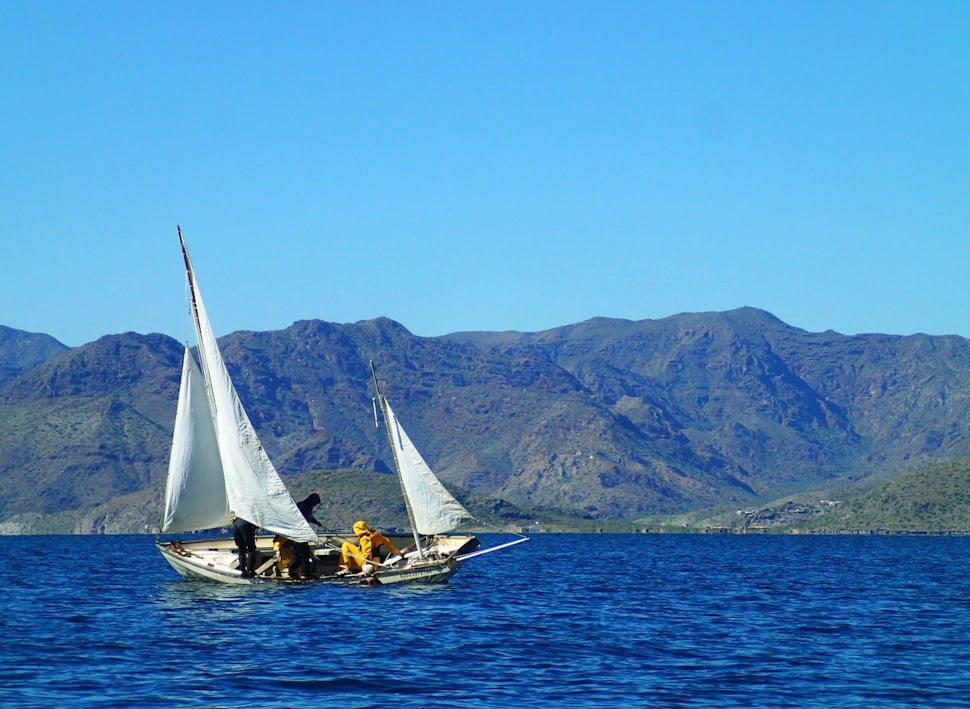
My mom always told me that I was brave. Brave for learning to play a new instrument, brave for trying out for a sports team, brave for venturing off on my own. During my three months in the backcountry on a NOLS course, however, I realized she was wrong. I wasn’t brave—I was scared.
When learning the violin became hard, I was too scared to put in more effort for fear that I still wouldn’t be any good, so I stopped practicing altogether. When my teammates in volleyball were put on the court over me I was too afraid to ask my coaches how I could improve so I could play more. Instead, I slacked off during practice and stopped taking myself seriously.

Photo by Orion-Bay Tucker.
Constantly in pursuit of unattainable perfection, I spent a lot of time chalking up my shortcomings to my own inadequacies. My semester in Baja changed that.
Only after I set out to hike the Sierra San Pedro Martyrs and navigate the Sea of Cortez did I begin to realize that what I viewed as a lack of ability was really a lack of bravery. Bravery to take a risk, bravery to do what I’ve spent my whole life avoiding: fail.
Out in the backcountry you can’t only give 50%. You can’t sort of locate yourself on a map, somewhat pack a boat, or maybe identify an anchorage.
You have to come with a plan and commit to it. You may be wrong, and you may end up nowhere near your intended X for the day, but you have to use the people around you and the skills you’ve learned to commit—and not worry about failure.
 Photo by Orion-Bay Tucker.
Photo by Orion-Bay Tucker.
I only began to understand this on my first day as designated leader.
With my group to help me, I had to plan the day from the time we left camp that morning until we reached our final X. By the light of my headlamp, I scrutinized the map the night before and wrote out the information I would need in my notebook: distances, changes in terrain, and potential hazards.
Despite my careful preparation, the day didn’t go as planned.
We had been bushwhacking for hours, in and out of drainages, up and over a ridge, when we were faced with yet another wall of thick, indestructible manzanita bushes. There was no clear path in sight; the trail we were supposed to come across was nowhere to be found. I was ready to accept defeat, sit down, and cry. Desert: 1, Mairin: 0.
 Photo by Valentina Hogenhuis.
Photo by Valentina Hogenhuis.
Lucky for us, our instructor was not ready to accept that score. My frustration completely transparent, he turned to me and said “Sometimes it’s not about being perfect, you just need to be brave. Pick the path of least resistance and go for it.”
I was thinking I had failed because the day wasn’t going according to the plan, but he was right. There wasn’t one right way to get to our destination. We couldn’t change the terrain, and we certainly couldn’t just give up and stay in that spot. We could, however, be brave.
 Photo by Valentina Hogenhuis.
Photo by Valentina Hogenhuis.
Spreading our maps out on a rock, we put our heads together and came up with a plan. We chose a small peak on the map that, based on the contour lines, looked like a shark’s fin. After identifying the “landshark” in the distance we set out, determined to get there.
No matter what obstacle we encountered, from then on we continued to head towards the landshark. It was our decision to come up with a plan and stick to it that kept us moving forward, no matter how slowly.
Reaching camp that night was one of the most rewarding feelings I have ever experienced. We were nowhere near our intended campsite, but we made it somewhere. We were tired, cold, and hungry, but we made it. We soldiered through one epic day and had the cuts and scrapes to show for it.
As we sat around the stove devouring a massive pot of quinoa and beans, for the first time that day, I no longer felt like I wanted to cry. Instead, I felt brave, or at least braver than I had that morning when I set out, clinging to my compass like it was the only thing that could save me.
 Photo by Orion-Bay Tucker.
Photo by Orion-Bay Tucker.
I realize that it seems too easy to write about how I can now accept my imperfections and go out into the world as a brave, risk-taking NOLS alumna. The reality is quite the opposite. Back in the frontcountry I still hesitate to raise my hand in class, unsure if what I have to say is up to the same caliber as my classmates. But every time I do speak up, I find my voice growing a little stronger.
When I left Baja, I couldn’t bring home the constellations, the dolphins jumping out of the water, or the beautiful aspen trees. I carry my experience with me in the small acts of bravery I complete throughout each day.
Whether it’s signing up for a club that I never thought to join or sharing something I wrote with others, it’s the little triumphs that keep my semester close in my mind. It is these moments that remind me that in the end it’s about being brave—not perfect.
Story by: Mairin Rogers
We want to acknowledge and thank the past, present, and future generations of all Native Nations and Indigenous Peoples whose ancestral lands we travel, explore, and play on. Always practice Leave No Trace ethics on your adventures and follow local regulations. Please explore responsibly!
Do you love the outdoors?
Yep, us too. That's why we send you the best local adventures, stories, and expert advice, right to your inbox.








